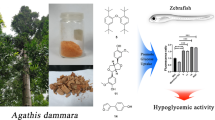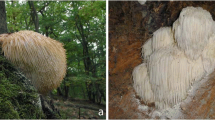Abstract
Six new naphthoquinones, euchronin A–F (1–6) and nine known naphthoquinones (7–15), were isolated from the roots of Arnebia euchroma (Royle) Johnst. The structures of the new compounds were confirmed by extensive spectroscopic analyses, including UV, IR, HR-ESI–MS, 1D and 2D NMR. In the present study, we estimated the anti-proliferative activities of these compounds with HaCaT cells. The results indicated that compounds 2 and 4 showed strong anti-proliferative activities at 25 μM, with relative viability at 38.83% and 68.44%, respectively.
Graphical Abstract




Similar content being viewed by others
References
Devi S, Sharma P, Sharma R, Thakur M (2023) Current status and medicinal prominence of Arnebia euchroma (Ratanjot): a critically endangered plant of trans-Himalayan region. Recent Pat Biotechnol 17(1):92–102. https://doi.org/10.2174/1872208316666220718154341
Wang A, Liu J, Yang Y, Chen Z, Gao C, Wang Z, Wang S (2021) Shikonin promotes ubiquitination and degradation of cIAP1/2-mediated apoptosis and necrosis in triple negative breast cancer cells. Chin Med 16:1–15. https://doi.org/10.1186/s13020-021-00426-1
Nasiri E, Hosseinimehr SJ, Hosseinzadeh AZ, Azadbakht M, Akbari J, Azadbakht M (2016) The effects of Arnebia euchroma ointment on second-degree burn wounds: a randomized clinical trial. J Ethnopharmacol 189:107–116. https://doi.org/10.1016/j.jep.2016.05.029
Cao H, Zhang W, Liu D, Hou M, Liu S, He W, Shao M (2020) Identification, in vitro evaluation and modeling studies of the constituents from the roots of Arnebia euchroma for antitumor activity and STAT3 inhibition. Bioorg Chem 96:103655. https://doi.org/10.1016/j.bioorg.2020.103655
Zhang Z, Bai J, Zeng Y, Cai M, Yao Y, Wu H, Ni J (2020) Pharmacology, toxicity and pharmacokinetics of acetylshikonin: a review. Pharm Biol 58(1):950–958. https://doi.org/10.1080/13880209.2020.1818793
Trautmann A, Disch R, Bröcker EB, Akdis CA, Gillitzer R (2003) Wie entsteht ein Ekzem? How does eczema arise? J Dtsch Dermatol Ges 1:8–11. https://doi.org/10.1046/j.1610-0387.2003.t01-1-02020.x
Li L, Zhong XQ, Lv CJ, Wei JA, Han L (2017) Preliminary study on proliferation inhibition and cytotoxicity of shikosin on human keratinocyte HaCaT. Lishizhen Med Mater Med Res 28:4
Frisch MJ, Trucks GW, Schlegel HB, Scuseria GE, Robb MA, Cheeseman JR, Barone V, Mennucci B, Petersson GA, Nakatsuji H, Caricato M, Li H, Hratchian HP, Izmaylov AF, Bloino J, Zheng G, Sonnenberg JL, Hada M, Ehara M, Toyota K, Fukuda R, Hasegawa J, Ishida M, Nakajima T, Honda Y, Kitao O, Nakai H, Vreven T, Montgomery JA, Peralta JE, Ogliaro F, Bearpark M, Heyd JJ, Brothers E, Kudin KN, Staroverov VN, Keith T, Kobayashi R, Normand J, Raghavachari K, Rendell A, Burant JC, Iyengar SS, Tomasi J, Cossi M, Rega N, Millam JM, Klene M, Knox OE, Cross JB, Bakken V, Adamo C, Jaramillo J, Gomperts R, Stratmann RE, Yazyev O, Austin AJ, Cammi R, Pomelli C, Ochterski JW, Martin RL, Morokuma K, Zakrzewski VG, Voth GA, Salvador P, Dannenberg JJ, Dapprich S, Daniels AD, Farkas O, Foresman JB, Ortiz JV, Cioslowski J, Fox DJ (2010) Gaussian 09, Revision D.01. Gaussian Inc, Wallingford, CT
Bruhn T, Schaumloffel ANU, Hemberger Y, Bringmann G (2013) SpecDis: quantifying the comparison of calculated and experimental electronic circular dichroism spectra. Chirality 25(4):243–249. https://doi.org/10.1002/chir.22138
Huang ZS, Wu HQ, Duan ZF, Xie BF, Liu ZC, Feng GK, Li YM (2004) Synthesis and cytotoxicity study of alkannin derivatives. Eur J Med Chem 39(9):755–764. https://doi.org/10.1016/j.ejmech.2004.05.004
Damianakos H, Kretschmer N, Sykłowska-Baranek K, Pietrosiuk A, Bauer R, Chinou I (2012) Antimicrobial and cytotoxic isohexenylnaphthazarins from Arnebia euchroma (Royle) Jonst. (Boraginaceae) callus and cell suspension culture. Molecules 17(12):14310–14322. https://doi.org/10.3390/molecules171214310
Li CJ, Fukushi Y, Kawabata J, Tahara S, Mizutani J, Uyeda I (1998) Antiviral and antifungal activities of some naphthoquinones isolated from the roots of Lithospermum erythrorhizon. J Pesticide Sci 23(1):54–57
Kim JY, Jeong HJ, Park JY, Kim YM, Park SJ, Cho JK, Lee WS (2012) Selective and slow-binding inhibition of shikonin derivatives isolated from Lithospermum erythrorhizon on glycosyl hydrolase 33 and 34 sialidases. Bioorg Med Chem 20(5):1740–1748. https://doi.org/10.1016/j.bmc.2012.01.011
Cho MH, Paik YS, Hahn TR (1999) Propionylshikonin from the roots of Lithospermum erythrorhizon. Arch Pharm Res 22:414–416. https://doi.org/10.1007/BF02979068
Shen CC, Syu WJ, Li SY, Lin CH, Lee GH, Sun CM (2002) Antimicrobial activities of naphthazarins from Arnebia euchroma. J Nat Prod 65(12):1857–1862. https://doi.org/10.1021/np010599w
Zhao HQ, Liu JF, Liu K (2010) Hydroxynaphthoquinone compounds from Arnebia euchroma and their inhibitory activities of phosphodiesterase 4. Chin J Exp Tradit Med For 16:96–99. https://doi.org/10.13422/j.cnki.syfjx.2010.10.036
Acknowledgements
Thanks for the support of the Key Research and Development Projects of Heilongjiang Province (GA21D008) and Heilongjiang Touyan Innovation Team Program.
Funding
This work was financially supported by the Key Research and Development Projects of Heilongjiang Province (GA21D008), Heilongjiang Touyan Innovation Team Program.
Author information
Authors and Affiliations
Contributions
Z-PZ: writing original draft. YL: validation and investigation. H-DZ: identification of compounds. JP: NMR test. Z-CH: cell test. WG: HR-ESI–MS test. AMA: check grammar and spelling errors. H-XK: corresponding author. B-YY: corresponding author.
Corresponding authors
Ethics declarations
Conflict of interest
No potential conflict of interest was reported by the authors.
Additional information
Publisher's Note
Springer Nature remains neutral with regard to jurisdictional claims in published maps and institutional affiliations.
Supplementary Information
Below is the link to the electronic supplementary material.
Rights and permissions
Springer Nature or its licensor (e.g. a society or other partner) holds exclusive rights to this article under a publishing agreement with the author(s) or other rightsholder(s); author self-archiving of the accepted manuscript version of this article is solely governed by the terms of such publishing agreement and applicable law.
About this article
Cite this article
Zhang, ZP., Liu, Y., Zou, HD. et al. Euchronin A–F isolated from the Arnebia euchroma (Royle) Johnst. and their anti-proliferative activities in vitro. J Nat Med 78, 33–41 (2024). https://doi.org/10.1007/s11418-023-01738-2
Received:
Accepted:
Published:
Issue Date:
DOI: https://doi.org/10.1007/s11418-023-01738-2




